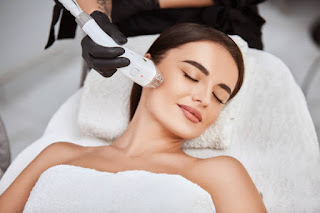Professional Acne Scar Treatments
Professional acne scar treatments are typically performed by dermatologists or cosmetic surgeons and can effectively improve the appearance of acne scars.Permanent Acne Scars Treatment in Islamabad, Rawalpindi & Pakistan Here are some common professional treatments for acne scars:
Chemical Peels:
Procedure: A chemical solution is applied to the skin, which causes it to exfoliate and eventually peel off, revealing smoother skin.
Benefits: Helps improve skin texture and reduce the appearance of mild to moderate acne scars.
Types: Superficial, medium, and deep peels, depending on the depth of the scars.
Microneedling (Collagen Induction Therapy)
Procedure: Tiny needles are used to create micro-injuries in the skin, stimulating collagen production and skin renewal.#
Benefits: Improves skin texture, reduces the appearance of scars, and enhances the penetration of topical treatments.
Types: Manual or automated microneedling devices.
Laser Resurfacing:
Procedure: Laser energy is used to remove the top layer of skin, promoting collagen production and revealing smoother skin.
Benefits: Effective for treating moderate to severe acne scars, with minimal downtime.
Types: Fractional lasers (e.g., CO2, erbium) target small areas of the skin, while non-ablative lasers (e.g., Nd
pulsed dye) stimulate collagen production without removing the top layer.
Dermal Fillers:
Procedure: Injectable fillers are used to fill in depressed acne scars, providing immediate results.
Benefits: Improves the appearance of atrophic scars, with results lasting several months to years, depending on the filler used.
Types: Hyaluronic acid fillers, collagen-stimulating fillers (e.g., Sculptra), and autologous fat transfer.
Subcision
Procedure: A needle is inserted under the skin to break up fibrous bands that are pulling down the skin, causing depressed scars.
Benefits: Helps release scar tissue and stimulate collagen production, improving the appearance of rolling or boxcar scars.
Often Combined With: Other treatments like laser resurfacing or microneedling for enhanced results.
Punch Techniques:
Procedure: A small tool is used to remove the scar tissue, which is then either stitched closed (punch excision) or filled with a graft or filler (punch elevation or punch grafting).
Benefits: Effective for treating deep or ice pick scars.
Types: Punch excision, punch elevation, and punch grafting.
Fractional Radiofrequency (RF) Microneedling:
Procedure: Combines microneedling with radiofrequency energy, which helps tighten the skin and improve acne scars.
Benefits: Stimulates collagen production and improves skin texture with minimal downtime.
Cryotherapy:
Procedure: Uses liquid nitrogen to freeze and destroy scar tissue, allowing new, healthy skin to form.
Benefits: Effective for treating raised or keloid scars, with minimal side effects.
Professional Treatment Considerations:
Multiple Sessions: Most professional treatments require several sessions for optimal results.
Downtime: Some treatments may have downtime, during which the skin may appear red, swollen, or peel.
Sun Protection: Protecting your skin from the sun is crucial after professional treatments to prevent hyperpigmentation and other complications.
Consultation: A consultation with a dermatologist or cosmetic surgeon is essential to determine the most appropriate treatment for your acne scars based on their type and severity.
Conclusion:




Comments
Post a Comment